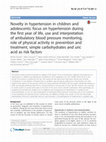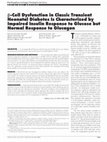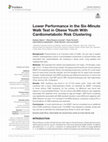Papers by Giuliana Valerio
International Journal of Environmental Research and Public Health
This narrative review aims to critically analyze the effects of exercise on health in aging. Here... more This narrative review aims to critically analyze the effects of exercise on health in aging. Here we discuss the main clinical and biomolecular modifications induced by long-term recreational football training in older subjects. In particular, the effects induced by long-term recreational football training on cardiovascular, metabolic and musculo-skeletal fitness, together with the modifications in the muscle expression of hallmarks related to oxidative metabolism, DNA repair and senescence suppression pathways and protein quality control mechanisms will be provided. All these topics will be debated also in terms of preventing non-communicable metabolic diseases, in order to achieve successful aging over time.
Italian Journal of Pediatrics
Current prevention strategies focusing only around the energy balance model have been found insuf... more Current prevention strategies focusing only around the energy balance model have been found insufficient to tackle the childhood obesity epidemic. Originating from the paper by Baranowski et al., recently published in Current Nutrition Report, this Commentary is aimed at discussing the complex etiology of obesity, on the ground of new biological models, which open a novel biobehavioral perspective of prevention.

International Journal of Environmental Research and Public Health
Aims. A nine-month motivational exercise-based intervention was previously offered to subjects wi... more Aims. A nine-month motivational exercise-based intervention was previously offered to subjects with type 2 diabetes (T2D). A year after the end of the intervention, compliance to physical activity (PA) and anthropometric indices of participants were analyzed to evaluate the durability of its effects. Methods. PA levels, expressed as total energy expenditure per week, were assessed with the International Physical Activity Questionnaire (IPAQ). Changes in Body Mass Index (BMI), A Body Shape Index (ABSI), Hip Index (HI) z-scores, the relative mortality risk related to each of these measures, and a combined Anthropometric Risk Index (ARI) were also evaluated. Results. Of a total of the 52 subjects examined (67.9% males, mean age 61.8 ± 6.0), 46 (88.4%) were still sufficiently active as defined by IPAQ thresholds at follow-up. PA levels, anthropometric indices and related risks improved at follow-up in respect to the baseline and to the end of the intervention, although only PA levels, B...
Italian journal of pediatrics, Jan 17, 2018
This review provides an overview of a remarkable number of significant studies in pediatrics that... more This review provides an overview of a remarkable number of significant studies in pediatrics that have been published over the past year in the Italian Journal of Pediatrics. We have selected information from papers presented in the Journal that deal with allergy, endocrinology, gastroenterology, genetics, immunology, infectious diseases, neonatology, nephrology, neurology, pulmonology. The relevant epidemiologic findings, and developments in prevention, diagnosis and treatment of the last year have been discussed and placed in context. We think that advances achieved in 2017 will help readers to make the future of patients better.

Italian Journal of Pediatrics, 2016
The present article intends to provide an update of the article "Focus on prevention, diagnosis a... more The present article intends to provide an update of the article "Focus on prevention, diagnosis and treatment of hypertension in children and adolescents" published in 2013 (Spagnolo et al., Ital J Pediatr 39:20, 2013) in this journal. This revision is justified by the fact that during the last years there have been several new scientific contributions to the problem of hypertension in pediatric age and during adolescence. Nevertheless, for what regards some aspects of the previous article, the newly acquired information did not require substantial changes to what was already published, both from a cultural and from a clinical point of view. We felt, however, the necessity to rewrite and/or to extend other parts in the light of the most recent scientific publications. More specifically, we updated and extended the chapters on the diagnosis and management of hypertension in newborns and unweaned babies, on the use and interpretation of ambulatory blood pressure monitoring, and on the usefulness of and indications for physical activity. Furthermore, we added an entirely new section on the role that simple carbohydrates (fructose in particular) and uric acid may play in the pathogenesis of hypertension in pediatric age.

We estimated perceived difficulty with physical tasks, lifestyle, and physical performance in 382... more We estimated perceived difficulty with physical tasks, lifestyle, and physical performance in 382 children and adolescents (163 obese, 54 overweight, and 165 normal-weight subjects) and the relationship between perceived physical difficulties and sports participation, sedentary behaviors, or physical performance. Perceived difficulty with physical tasks and lifestyle habits was assessed by interview using a structured questionnaire, while physical performance was assessed through the six-minute walking test (6MWT). Obese children had higher perceived difficulty with several activities of daily living, were less engaged in sports, and had lower physical performance than normal-weight or overweight children; on the contrary, they did not differ with regard to time spent in sedentary behaviors. Perceived difficulty in running and hopping negatively predicted sports participation (< 0.05 and <0.01, resp.), while perceived difficulty in almost all physical activities negatively predicted the 6MWT, independently of BMI (< 0.01). Our results indicate that perception of task's difficulty level may reflect an actual difficulty in obese children. These findings may have practical implications for approaching physical activity in obese children. Exploring both the perception of a task's difficulty level and physical performance may be useful to design exercise programs that allow safe and successful participation.

Diabetes Care, 2004
OBJECTIVE—To investigate β-cell function and the long-term health of four case subjects presentin... more OBJECTIVE—To investigate β-cell function and the long-term health of four case subjects presenting with chromosome 6–associated transient neonatal diabetes (TND). RESEARCH DESIGN AND METHODS—Two unrelated case subjects presenting with paternal uniparental isodisomy of chromosome 6 (UPD6) and two siblings with a paternally inherited duplication of 6q24 were studied. Three case subjects presented with neonatal diabetes that recurred at 4–17 years, while diabetes was incidentally discovered in the other case subject at 14 years of age. β-Cell function was investigated after diabetes relapse by means of an oral glucose tolerance test (OGTT), an intravenous glucose tolerance test (IVGTT), and glucagon tests. The quantitative insulin sensitivity check index (QUICKI) was calculated from fasting blood samples as an estimate of insulin sensitivity. RESULTS—β-Cell function was investigated at diabetes relapse in two case subjects: the insulin response to both an OGTT and IVGTT was low, wherea...
Consciousness and Cognition, 2011
Tissue …, 1990
Abstract: Human T lymphocyte proliferative response induced via CD28 molecule is analyzed. An ant... more Abstract: Human T lymphocyte proliferative response induced via CD28 molecule is analyzed. An anti CD28 MoAb, CLB-CD28/1, induces the proliferation of human peripheral blood mononuclear cells in the absence of other stimuli, indicating that CD28 molecule can ...
… journal of urology …, 2003
Objective: To compare the effects of medical therapy on boys with cryptorchidism, a prospective s... more Objective: To compare the effects of medical therapy on boys with cryptorchidism, a prospective study was carried out in five groups of patients over a 30-month period. Material and Methods: A total of 439 boys with undescended testicles were enrolled; their ages ranged ...
NeuroImmune Biology, 2002
... critical questions remain unanswered on the clinical importance of the interaction between GH... more ... critical questions remain unanswered on the clinical importance of the interaction between GH, IGF-I and the immune system such as the potential role of these hormones as: (1) immunotherapeutic agents in clinical states of immunodeficiency, (2) immunomodulants in critically ...
American journal of …, 2001

Frontiers in Endocrinology
Background: Physical fitness is an important index of health. Our aim was to assess whether cardi... more Background: Physical fitness is an important index of health. Our aim was to assess whether cardiorespiratory and/or musculoskeletal components of physical fitness were associated with cardiometabolic risk clustering in obese youth, using adapted and validated field tests. Methods: We evaluated 252 children and adolescents (132 males, 120 females), mean age 10.9 ± 1.9 years with primary obesity. All subjects performed the six-minute walk test (6MWT) for assessing aerobic fitness, the standing broad jump, and the 30 s-chair stand tests for lower-body muscular strength, and the handgrip test for upper body isometric strength. Cardiometabolic risk (CMR) clustering was defined as having two or more of the following risk factors: high SBP and/or DBP, impaired fasting glucose, high triglycerides (TGs), and low HDL-Cholesterol. Results: CMR clustering was found in 44 (17.5%) obese youth. Youth with CMR clustering had a lower cardiorespiratory fitness, as assessed by 6MWT, compared to those without CMR clustering. On the contrary, no difference was found with respect to musculoskeletal fitness. The six-minute walk (6MW) distance was negatively associated with sedentary time, controlling for age and height. CMR factors clustering was significantly associated with BMI standard deviation score (SDS) and negatively with 6MW distance: for each 10-m increase in the 6MW distance, a reduction of about 9% in the prevalence of CMR clustering was expected. Conclusions: A lower performance in the 6MWT may be considered as an additional trait of CMR clustering in obese youth. The 6MWT may represent a valuable, simple and low cost test to estimate the cardiorespiratory fitness in youth with obesity.

In th e last few years the immunological methods for measurement of serum GH have been subject to... more In th e last few years the immunological methods for measurement of serum GH have been subject to criticism because of discordance between resulls oblained from different laboratories and poor sensitivity of most assay systems. Aim of our study was to develop an ullra-sensitive assay for GH and to evaluate its utility for the assessment of the GH secretory status. For this purpose we adapted an ELISA-test for the measurement of GH in urin e to the measurement of serum GH. Due to the high concentration of serum GH versus urinary GH , a dilution of the serum samples was required. The assay is performed in microliter plates coated with a monoclonal GH antibody. Sample size is 1001'1 serum diluted I: I 00 or I :400. The assay is completed within 24 hours. The characteristics of this ultra-sensi tive GH assay are as follows: minimum delectable concentration: 0.514 ng/L; intraassay coefficients of variation: 10.9% (1.80 ng/L) and 4.4% (9.74 ng/L); intcrassay coefficients of variation: 17.5% and 13.8% at the same concen trations. Serial dilutions of serum samples were linear and parallel to the standard curve. For th e Iauer r-hGH was used. To assess the utility of the assay, we measured a) samples from 24 hour studies in healthy adu lt volunteers; b) samples drawn before and after stimulation of GH in children operated for craniopharyngioma. A concentration of GH could be measured in every single serum sample, the lowest found so far being 0.97 ng/L, a val ue which is statistically different from the minimum detectable concentration for the assay. This ultra-sensitive assay for GH should open new perspectives for the investigation of GH secretion.

Objectives: There is no agreed-upon definition for severe obesity (Sev-OB) in children. We compar... more Objectives: There is no agreed-upon definition for severe obesity (Sev-OB) in children. We compared estimates of Sev-OB as defined by different cut-points of body mass index (BMI) from the Centers for Disease Control and Prevention (CDC) or the World Health Organization (WHO) curves and the ability of each set of cut-points to screen for the presence of cardiometabolic risk factors. Research Design and Methods: Cross-sectional, multicenter study involving 3,340 overweight/obese young subjects. Sev-OB was defined as BMI $99 th percentile or $1.2 times the 95 th percentile of the CDC or the WHO curves. High blood pressure, hypertriglyceridemia, low High Density Lipoprotein-cholesterol and impaired fasting glucose were considered as cardiometabolic risk factors. Results: The estimated prevalence of Sev-OB varied widely between the two reference systems. Either using the cut-point $99 th percentile or $1.2 times the 95 th percentile, less children were defined as Sev-OB by CDC than WHO (46.8 vs. 89.5%, and 63.3 vs. 80.4%, respectively p,0.001). The CDC 99 th percentile had lower sensitivity (58.5 vs 94.2), higher specificity (57.6 vs 12.3) and higher positive predictive value (34.4 vs 28.9) than WHO in identifying obese children with $2 cardiometabolic risk factors. These differences were mitigated using the 1.2 times the 95 th percentile (sensitivity 73.9 vs. 88.1; specificity 40.7 vs. 22.5; positive predictive value 32.1 vs. 30.1). Substantial agreement between growth curves was found using the 1.2 times the 95 th percentile, in particular in children #10 years. Conclusions: Estimates of Sev-OB and cardiometabolic risk as defined by different cut-points of BMI are influenced from the reference systems used. The 1.2 times the 95 th percentile of BMI of either CDC or WHO standard has a discriminatory advantage over the 99 th percentile for identifying severely obese children at increased cardiometabolic risk, particularly under 10 years of age.

Behavior Genetics, 2011
The present study was aimed at investigating the spatial abilities in Prader-Willi syndrome (PWS)... more The present study was aimed at investigating the spatial abilities in Prader-Willi syndrome (PWS) by using the Radial Arm Maze (RAM) task. We trained PWS individuals with the deletion subtype in two different RAM paradigms that tapped different aspects of spatial memory. To evaluate the extent of spatial deficit in PWS individuals, it seemed interesting to compare their performances with those of individuals with Williams syndrome (WS) in which deficits in spatial abilities have been well described. The two syndromic groups were compared to typically developing (TD) individuals mental-age and gender matched. The findings evidenced the impairment of PWS individuals in solving the RAM task with variable severity depending on the paradigm requests. Since the RAM is a task that allows the acquisition of spatial competences through the movement, we advance that the spatial deficits observed in PWS individuals may be related to the malfunctioning of spatial and motor integrative processing.

Acta Paediatrica, 2001
Valerio G, Franzese A, Carlin E, Pecile P, Perini R, Tenore A. High prevalence of stress hypergly... more Valerio G, Franzese A, Carlin E, Pecile P, Perini R, Tenore A. High prevalence of stress hyperglycaemia in children with febrile seizures and traumatic injuries. Acta Paediatr 2001; 90: 618-622. Stockholm. ISSN 0803-5253 Although hyperglycaemia is relatively frequent in the course of severe illnesses and may be looked upon as the possible result of an uncoordinated insulin response to the increased glucose that the body may need during periods of stress, it is generally agreed that it does not constitute a prediabetic condition. Numerous studies have aimed to explain the pathophysiology of this occurrence but none has looked at which conditions are more prone to develop stress hyperglycaemia (SH). Therefore, the aim of this study was to evaluate the main clinical conditions that may be associated with SH in children. A total of 1199 children was studied: 833 children (439 M, 394 F, mean age 5.2 § 4.5 y) admitted for an acute illness or injury constituted the stressexposed group, while 366 children (222 M, 144 F, mean age 6.2 § 4.6 y) admitted for elective minor surgery represented the stress-unexposed group and were considered as the control group. SH was de ned as plasma glucose concentrations ¶8.3 mmol l ¡ 1 during an acute illness. Stressexposed patients had signi cantly higher glycaemic levels than controls (5.6 § 1.4 vs 4.7 § 0.7 mmol l ¡ 1 ; p < 0.0001). SH was found in 41 (4.9%) stress-exposed patients and in none of the controls. SH was signi cantly more prevalent in children affected by febrile seizures (12.9%) or traumatic injuries (11.7%; p < 0.008 and p < 0.02, respectively, vs other diagnoses). A signi cant correlation was found between glycaemia and systolic pressure (r = 0.1; p < 0.01), white cell count (r = 0.12; p < 0.0003) and body temperature (r = 0.16; p < 0.0001). SH was more frequent in patients with body temperature >39°C (14%) than in those with a temperature µ39°C (4%; p < 0.0008). SH was more prevalent in clinical conditions of fever associated with seizures or pain (12.9% and 12.5%, respectively) than fever alone (4.4%). After a mean period of 3.5 § 0.6 y of follow-up none of the hyperglycaemic patients had developed diabetes mellitus.
Uploads
Papers by Giuliana Valerio